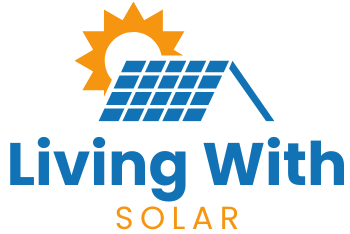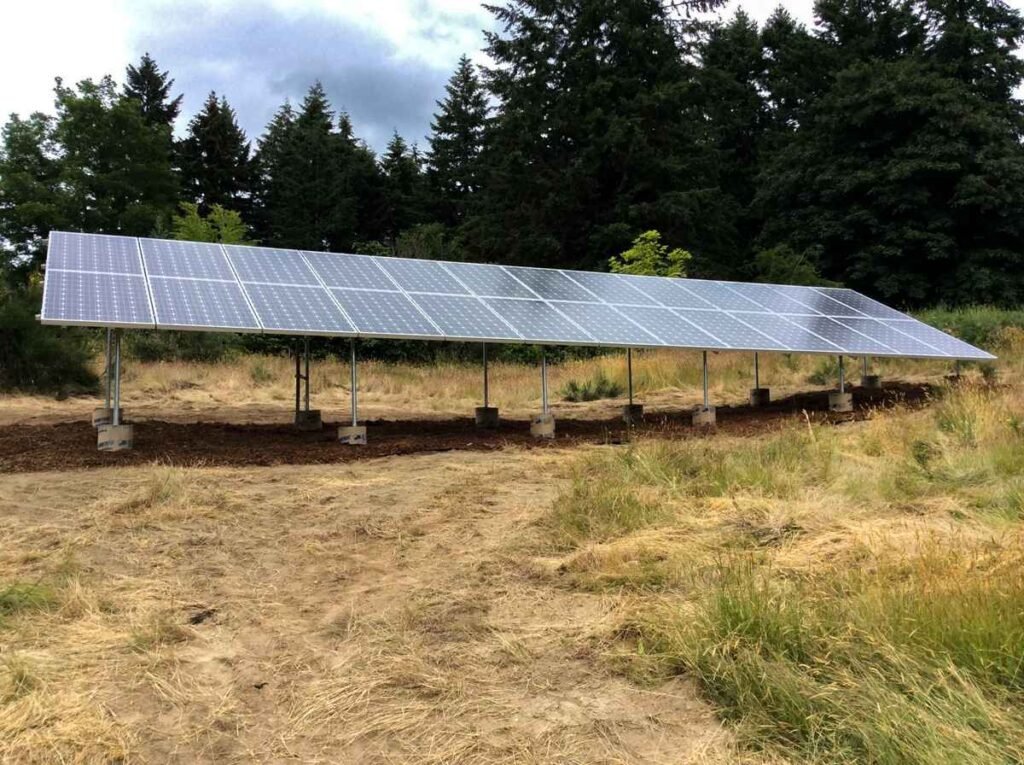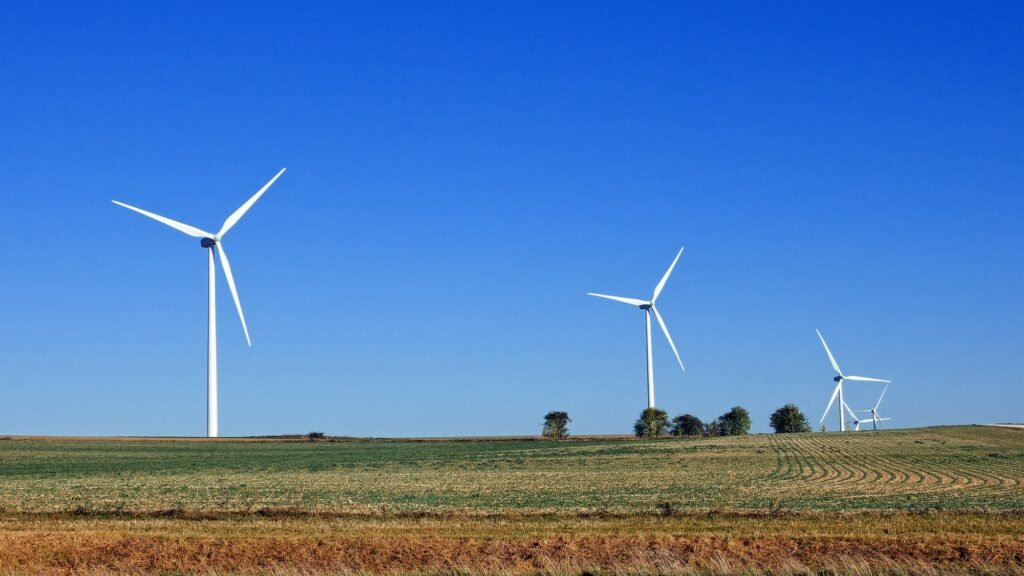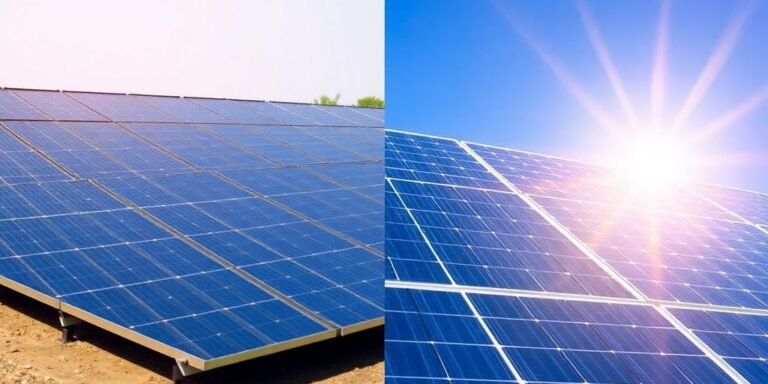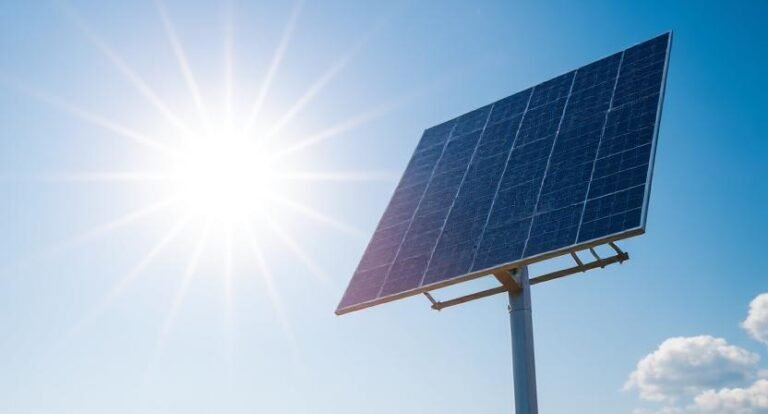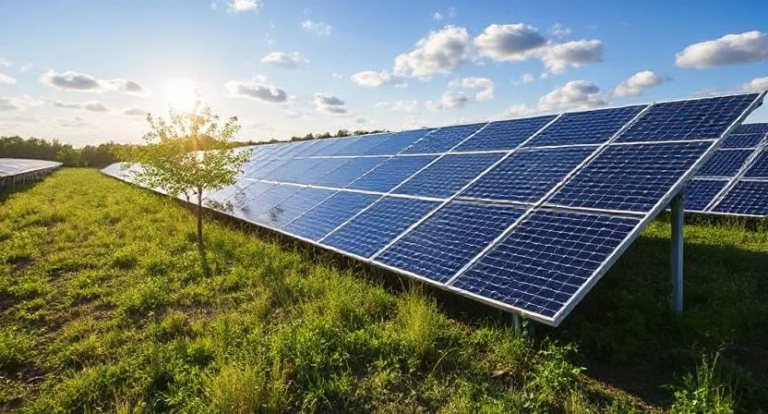Considering going solar but not crazy about putting panels on your roof? 100 PERCENT RENEWABLES How do I power my refrigerator with green energy? Backyard solar panels could be the answer.
These akin systems, commonly known as ground-mounted solar panels, provide an alternative route to collect the sun’s energy. They offer you more freedom about where they are placed, and in some cases, they can even produce more electricity than rooftop ones.
But they’re not for everyone. They take up quite a bit of space, and can be a little pricier upfront. This guide will teach you everything you need to know about backyard solar panels and whether they’re right for your home.
What Are Backyard Solar Panels?
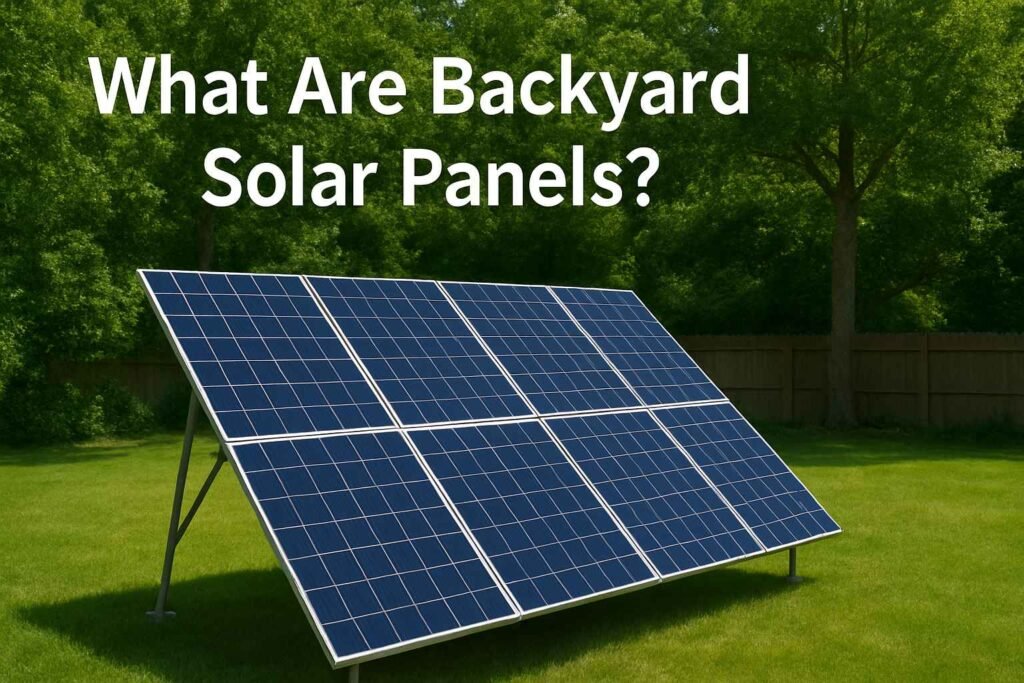
When I use the term “backyard solar,” I’m defining it as ground-mounted solar panels that somebody installs in their yard, instead of on their roof. It’s a pretty simple idea, but it presents all sorts of potential opportunities for homeowners who don’t have the best possible roof for solar. Think of this as adding a mini solar farm to your home right on your very own property.
I’ve long been interested in the notion of making my power. I think the idea of achieving backyard energy independence, my home runs on sunshine, brings a great deal of appeal.
My whole decision is not for saving money, it’s about where my power comes from, and keeping it, so that at the end of all of this, I’m having a reduced impact on the environment.
These systems usually consist of a support, typically a rack, which holds the solar panels in place on the ground. This setup is so much more flexible compared to rooftop installs. You’re not, for example, stuck with the direction or size of your roof.
You can position your backyard solar array such that it receives optimal sun throughout the day, significantly ramping up the electricity you generate. And if you need to increase your setup one day, it’s generally easier to add more panels to a ground mount than to a roof.
A standard backyard solar panel system includes all of the following components:
- Solar Panels: The Show Stoppers, turning sunlight into electricity. There are different types — from monocrystalline to polycrystalline, each with its levels of efficiency.
- Mount Structure: This is the frame that the panels fit into. This may be a fixed tilt (the panels are at an angle) or a tracking system that adjusts the panels throughout the day so they’re always pointed at the sun for the most output.
- Inverter: This important device turns the direct current (DC) electricity generated by your panels into alternating current (AC) electricity, running the appliances in your home.
- Wiring & Electrical Components: All required wiring, conduit, and safety disconnects to connect the system to your home’s electric service panel.
- Optional Battery Storage: With the rising popularity of battery storage, many homeowners are including a battery storage backyard system to save unused energy produced during the day to use at night or when power is out. This helps with energy independence.
And some people are choosing to install solar panel kits in their backyard, which can be a more DIY-friendly process, while others want a professional to install a bigger and potentially more complex system.
Either way, more and more folks are looking beyond the traditional rooftop system and considering solar panels in their backyard as a way to go green without all the limitations of a roof-mounted setup.
How Backyard Solar Panels Work

So, you think you want to get into backyard solar panels, eh? I get it. It’s kind of cool to imagine generating power right there in your backyard. In essence, these systems convert sunlight into electricity using photovoltaic (PV) panels. The panels are composed of semiconductor material (most commonly silicon) that converts sunlight directly into direct current (DC) electricity. It’s magic, but it is also science.
This DC power moves to an inverter, which converts it to alternating current (AC) power (the kind of power that your appliances need when they’re plugged into the wall). From there, the AC power can flow directly into your home to power your lights and gadgets, or you can send it back to the grid, depending on your configuration. It’s a cool way to start using home solar power.
Grid-Tied vs Off-Grid Options
When it comes to backyard solar, you have a couple of main options: grid-tied or off the grid. Each type has its pros and cons, and what’s best for you depends on your energy needs and how much freedom you want from the utility company.
Grid-Tied Systems
These are often the most popular choice. Your solar panels are then plugged into the electricity grid. When your panels generate more electricity than you are using, the surplus electricity flows back into the grid, and you often receive credits from your utility company (a concept known as net metering).
When your panels aren’t making enough, it’s dark or cloudy out, you buy back grid electricity. This configuration is the best of both worlds; you lower your electricity bill and secure a dependable source of power. It’s an easy way to incorporate solar power in tight spaces without radically altering your lifestyle. Installation costs for these systems may vary quite a bit.
Off-Grid Systems
These are for people who want total independence from the utility grid. Your home is powered by the solar panels, which charge a battery bank. You have no grid connection at all. That’s because you need a good energy storage system to capture lots of the energy you need, particularly during low sunshine. This is a more substantial upfront investment and will take more careful planning to ensure you have enough stored energy. But man, does it feel good to be a bona fide self-starter.
Hybrid Systems
Some like a hybrid system that mixes and matches. You’re tied to the grid, but you also have battery storage. That way, you get the advantage of net metering and receive backup power during outages. It’s a nice compromise if you’d like some independence, but neither are you ready to fully sever ties with the grid.
I’ve also found that understanding those differences is crucial for making an informed decision about what to buy before you invest in a backyard solar setup. It’s not just the panels in the yard; it’s how they fit together as part of the bigger picture of your overall energy use.
Battery Storage Integration
Battery storage can be a big one too, especially if you’re considering an off-grid or hybrid system. There’s the possibility that even if you’re grid-tied, having batteries could be a game-changer. Here’s why:
Energy Independence:
Batteries allow you to store that extra electricity you make with your panels during the day. That means you can draw on that power at night or when the sun isn’t shining, minimizing your reliance on the grid. It’s like having a personal power bank for your house. Living with solar power becomes a lot more flexible when you have batteries.
Backup Power:
When the grid is down, battery storage makes it possible to run your critical load. Never grope around for a flashlight during a power outage again! And that peace of mind is often priceless for homeowners.
Optimized Energy Usage:
You can schedule your smart battery to charge during times of day when electricity is cheapest, and discharge when it’s most expensive, or if you have time-of-use billing. That can save even more off your electricity bill. It’s all about working smarter, not harder, with your solar power.
Sizing Your System:
You will need to consider how long you want to be able to rely on battery power for, and based on that, determine the size of your battery bank. It’s not a one-size-fits-all situation. To find the right capacity, you’d have to determine your average daily energy use. Prior to installation, it’s wise to think through your energy requirements very carefully.
How Much Do Backyard Solar Panels Cost?

So, it’s time to put solar panels in the backyard, huh? It’s a great idea, but let’s address the elephant in the room: the price. I’ve been researching this quite a bit lately, and it’s no small investment, I can tell you that much.
The average price for a ground-mounted solar system, and that’s before any tax incentives apply, is about $53,800. Yes, that’s a very big number. It’s about 10% to 15% more pricey, in fact, than slapping panels on your roof. But hey, if the roof isn’t right for solar, or you just don’t want them up there, backyard panels are a reasonable alternative.
I’ve discovered that even if the upfront cost feels steep, the long-term savings on your electricity bill can add up. It’s kind of like getting a super-efficient car; you pay more upfront, but reap the rewards on gas over the years. Additionally, there are frequently incentives that can lower that cost.
When you are pinning down the bottom line, here are a few factors that can make a big difference:
System Size:
This is likely the most important contributor. The more power you want to produce, the more panels you will need, and the more you’ll pay. It’s all about sizing the system to your household’s needs for energy.
Equipment Quality
As with anything, there’s a spectrum of quality in solar panels and inverters. High-efficiency panels may be more expensive upfront, but could produce more power over their lifetime. I’ve been exploring other brands, and there are differences in warranties and performance ratings.
Installation Difficulty
If you have an ultraportable, level backyard with great access, installation could be faster and cheaper. But if they have to do a good deal of grading or dig long trenches for the wiring, that will add to the labor costs. I’ve heard tales of tricky installations driving up the price.
Permits and Inspections
Don’t sleep on this one! Every jurisdiction has its regulations, and obtaining all the necessary permits and securing all the required inspections often adds to the overall cost and timeline. It’s an important process to ensure everything is up to code and safe.
Battery Storage
If you want to power your home when it’s dark or when there’s a power outage, expect to pay much more for battery storage. But for others, that peace of mind is worth the extra cost. I’m still on the fence about it whether I need batteries or not.
Here’s a rough guide to what you might expect to pay for a typical residential ground-mounted system:
| Component | Estimated Cost Range |
|---|---|
| Solar Panels | $15,000 – $30,000 |
| Inverter | $2,000 – $5,000 |
| Racking & Mounting | $3,000 – $8,000 |
| Installation Labor | $10,000 – $20,000 |
| Electrical Work | $2,000 – $5,000 |
| Permits & Fees | $500 – $2,000 |
| Battery Storage (Optional) | $8,000 – $20,000 |
Remember, these are all ballpark figures, and costs can vary widely based on where you live and the particular company you choose. It’s always wise to get a sense of a few estimates to compare. I’m going to get at least three estimates before making any decisions. This is a major life decision, and I need to ensure I’m getting the best solar panel installation cost.
Backyard Solar Panels: Do You Need Permits?

So, you want to install solar panels in your backyard, huh? That’s awesome! But tonight, before you dig, we need to have a super, duper important talk: permits. Yeah, I know, it doesn’t sound very sexy, but believe me, it will save you more headaches down the line than you’ll ever realize. It’s not merely a matter of getting the panels up; it’s about ensuring that everything is on the up and up, legally and safety-wise.
Rules can change from town to town or, in some cases, even block to block, and you don’t want to be caught unaware. Obtaining proper permits is a must-have step for any backyard solar panel project. I mean, imagine setting everything up and then you’re told to break it all down because you didn’t get a piece of paper. No thanks!
Zoning & HOA Rules
OK, let’s unpack the first barrier: zoning and HOA rules. These are the people who tell you what you can and can’t do with your property.” Local Zoning Laws are determined by your local government and include rules about things such as how far structures must be from your property line, how high they can be, and sometimes what they can look like.
It’s about maintaining order in the community. For instance, in some locales, there are very strict requirements about how visible from the street your solar panels can be. You might say, “It’s my backyard, so what?” but the city cares.
And there are HOAs, or Homeowners Associations. If you live in a neighborhood with an HOA (hello!), you have another layer of rules to navigate.
These can be stricter than zoning laws. They may have aesthetic standards or approved materials they require, even bans on certain types of installations. I’ve heard of people who have had to fight their HOA tooth and nail to get panels approved. It’s a good idea to:
- Review any solar panel clauses in your HOA’s covenants, conditions, and restrictions (CC&Rs).
- Draw up a more specific plan to send to your HOA for approval before you start any work.
- Be open to modifying your plan according to their feedback.
It’s simply better to get their blessing proactively and early. The last thing you want is to buy a home solar energy system and then be told by your HOA that you can’t have it.
Ground-Mount Installation Regulations
Now, let’s address ground mount installations, which is what home solar in the backyard is. Ground mounts have their own rules, which tend to be different than those for rooftop systems. These can include things like:
- Setback requirements: How far away the panels must be placed from your property lines, decks, or other structures on your property.
- Restrictions on height: Your ground-mounted array might be limited in how tall it can be, particularly if it’s visible from adjacent lots.
- Foundation needs: Because these panels will be on the ground, the foundation must be able to stand up to wind and other weather. This can involve rather precise engineering requirements.
- Electrical codes: When it comes to electrical work in your home, both the panels and the wiring for your main home electrical panel have to adhere to strict safety codes. This typically demands a licensed electrician to inspect the installation.
I always recommend that you first check with your local building department. They’re the ones who can provide you with the definitive answers on what permits you will require and which regulations will pertain to your particular property.
Resist the temptation to go by what you heard and what your neighbor did five years ago; rules change! They can even remind you whether your property is a good candidate for solar panel installation at all.
Securing those permits might seem like a load of paperwork and waiting around, but it’s an important step to ensure that your backyard solar project is up to code and safe. Let me tell you, the peace of mind is worth it.
How to Install Solar Panels in Your Backyard
No question about it: Backyard solar panels can seem like a major project, but with a little effort, it’s much easier than you might expect. Along the way, I’ve learned a few things that I believe are important for anyone looking into a residential solar ground-mount installation. Skilled solar installers make it work. It isn’t just about getting the panels up; it’s about ensuring they will function well for years to come.
Site Preparation and Assessment
Before picking up a panel, you need to study your backyard. I mean, look at it. It all starts with choosing the right place if you want your DIY solar panel installation to be successful. You’re looking for an area that gets boatloads of sun all day long year-round. I walked around my yard at various times, staring at where the shadows fell.
Trees, your home, even a neighbor’s shed, might throw more shade than you’d guess. Then you have to consider the ground itself. Is it level? Is it prone to flooding? You may have to grade or opt for another location if the ground is unstable.
I discovered that spending as much time as needed to truly understand the site saved me from a world of pain. It’s quite tempting to get straight to the fun part, but taking shortcuts can mean working harder down the line and having inefficient panels.
Choosing the Right Mounting System
There are a few options for mounting backyard solar panels, and the best one for you will depend on your particular setup. I went through a bunch of options before making mine work. Here’s a quick rundown:
- Fixed Tilt Mounts: Guys, these are simple. The panels are angled a certain way, often tailored for your latitude, and they don’t move. They are usually the cheapest and easiest to install.
- Tilt Mounts: .These tilt mounts give you the freedom to adjust the angle of your panels throughout the year, so that you get the most sunlight no matter where you live. It’s a little more work, but you can get better performance, especially in seasons with more oblique sun angles.
- Tracking Systems: These are the most sophisticated and have motors that move the panels to track the sun as it moves across the sky. They generate the most energy, but are the most costly and difficult to install. For a backyard set up, I felt these were overkill.
I ultimately settled on adjustable tilt mounts. It was a just a compromise between the price and the work that would fulfill my needs. You’ve also got to think about what it’s made of — galvanized steel or aluminum are common choices, since they stand up well to the elements.
Electrical Connections and Safety
And here’s where things get serious. Unless you are a certified electrician, I wouldn’t mess around with the electrical hookup without help.
I managed all of the physical installation myself, but when it came time to hook everything up to my home’s electrical system, I brought in an expert.
To make sure it works is not the only thing; it’s a safety issue and about following local codes. Before you even begin, double-check that you’ve done your solar panel installation prep work. You probably don’t want to accidentally electrocute yourself or cause a fire.
Here are some important electrical considerations:
- Inverters: You’ll also need inverters (s) to convert the DC power generated by your panels to AC power that your home can use. String inverters are standard, but with microinverters (one per panel), performance can be higher if one panel is shaded.
- Wire: All wire must be of the correct size and protected from the elements. Conduit is your friend here.
- Grounding: Grounding is absolutely crucial for safety. This is protection from power surges and lightning.
- Disconnects: You will require an acceptable means of disconnecting the solar system from the electrical grid of your home for both maintenance and emergencies.
I confirmed all my plans with an electrician before buying any electrical components. Better safe than sorry, especially when it comes to electricity. I didn’t put my panels on a roof, but the considerations involved in installing solar panels on a roof to electrical standards are quite similar.
Best Backyard Solar Panel Systems in 2025
When considering the best backyard solar panel systems for 2025, I’m really considering a couple of things: How efficient they are, how long they last, and how well they fit into different setups.
More than just getting power, it is about getting the right power for the precise applications you can afford. Whether you’re hoping to invest in rural solar energy solutions or simply trying to trim your electric bill at work, there’s a system out there for you.
Top Picks for Ground-Mounted Systems
But for those who have the space, ground-mounted systems are frequently the way to go. They allow you to perfectly angle the panels to get the most sun, which is a huge bonus. I have seen some amazing systems that just pump power. Here are two such systems that look especially promising:
SunPower Equinox System: What the heck: This one’s even stronger still. SunPower panels are valued for their high efficiency, which is to say that more sunlight is turned into electricity. Everything, down to the panels and inverters, is part of the Equinox system, and it’s a pretty straightforward operation. It is a bit of an expense, but the long-term savings and usability are generally worth it.
LG NeON R: LG may be most famous for its TVs, but you can also expect quality solar panels from the brand. The NeON R series has very high efficiency, even in low light, so if you have some partial shading, you’re in a good place. They’re also manufactured to endure, which is something I’m always looking for.
REC Alpha Pure-R: REC panels are a nice option to consider. Their Alpha Pure-R series features next-generation cell technology to enhance performance. They are also built to be extremely durable, which is crucial for any outdoor installation.
Best Off-Grid Solar Systems
Whether you’re considering getting completely off the grid, or merely peace of mind in an emergency, or a reliable dry camping power source, an off-grid solar system is simply a great solution. Such systems will generally comprise panels, a charge controller, storage batteries, and an inverter. A sturdy battery bank is everything in off-grid life. They need to have a lot of energy stored up so there’s enough to carry a leafy crop through even a string of cloudy days or a night.
These are some of the components and systems I would consider to power an off-grid setup:
- Victron Energy Products: Victron manufactures some of the highest-quality charge controllers and inverters on the market. They’re dependable and come packed with features that make it simple to keep an eye on and take care of your system. I’ve heard good things about their MultiPlus inverter/chargers.
- OutBack Power Systems: OutBack provides integrated off-grid solutions for applications that require serious power. Their Radian line of inverters is quite popular for whole-home off-grid systems. Not to mention that they are built to last and can take a beating.
- Battle Born Batteries: Batteries_lithium_ion batteries, lithium ion is best for off-grid. Battle Born makes some great (LiFePO4 chemistry) batteries that are lightweight, long-lasting, and can be deeply discharged. They’re a game changer for storing energy.
When I’m dealing with these systems everywhere, I think about the bigger picture. It’s not just the panels; it’s the inverters, mounting hardware, and especially the battery storage for off-grid systems. You need a system that cooperates in a trustworthy and efficient manner for many years to come. Do not cut corners on the parts, especially if you are using it for all of your power.
Portable and Flexible Options
In some cases, a big, proper ground-mounted system simply isn’t practical. Perhaps you’re cramped on space, or you’re in the market for a model you can take with you elsewhere. That’s where portable and flexible solutions come into play. These are ideal for smaller applications, such as powering a shed, an RV, or just charging some devices outdoors.
Goal Zero Yeti Power Stations with Solar Panels:
Goal Zero has its lines of portable power stations that can be charged by their solar panels. They are very quick and easy to set up and use, great for camping or emergency backup. I’ve been taking it myself for and it is super handy.
Renogy Solar Kits:
Renogy has multiple solar kits with flexible and portable panels. They’re great for building your own small, purpose-specific system. Their customer service is also pretty good if you have questions.
Jackery Portable Power Stations:
Just like Goal Zero, they are offering a range of portable power stations that are also compatible with solar panels. They’re also small and efficient, the perfect power source for on the go. I know many, many folks who use these for backyard projects or even to power outdoor lights.
The best system for you depends on your situation and how much power you require. It may be worth going on a bit of a hunt and maybe even getting a few quotes to see what makes the most sense for your backyard.
